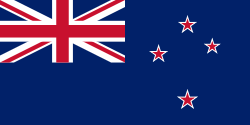New Zealand
Newzealand ko Niyu Zilan[1] (da Turanci, New Zealand) kasa ce, da ke a Oseaniya. Babban birnin ƙasar newzealand Wellington ne; birnin mafi girman kasar Auckland ne. Sabuwar Zelandiya tana da yawan fili kimani na kilomita murabba'i 268,021. Newzealand tana da yawan jama'a 5,005,400, bisa, ga jimilla a shekarar 2020. Akwai tsibirai dari shida(600) a cikin kasar newzealand. Newzealand ta samu yancizen kanta a shekara ta 1907.
| Aotearoa (mi) | |||||
|
|||||
 | |||||
|
| |||||
| Take |
God Defend New Zealand (en) | ||||
|
| |||||
|
| |||||
| Kirari | «100% Pure» | ||||
| Suna saboda |
Zeeland (en) | ||||
| Wuri | |||||
| |||||
| Babban birni | Wellington | ||||
| Yawan mutane | |||||
| Faɗi | 5,118,700 (2021) | ||||
| • Yawan mutane | 19.1 mazaunan/km² | ||||
| Harshen gwamnati |
Māori (en) New Zealand Sign Language (en) Turanci | ||||
| Labarin ƙasa | |||||
| Bangare na |
Australasia (en) | ||||
| Yawan fili | 268,021 km² | ||||
| Wuri mafi tsayi |
Aoraki / Mount Cook (en) | ||||
| Wuri mafi ƙasa |
Taieri Plain (en) | ||||
| Sun raba iyaka da | |||||
| Bayanan tarihi | |||||
| Mabiyi |
Colony of New Zealand (en) | ||||
|
26 Satumba 1907: Dominion of the British Empire (en) 13 Disamba 1986: Ƴantacciyar ƙasa | |||||
| Muhimman sha'ani |
Statute of Westminster 1931 (en) | ||||
| Tsarin Siyasa | |||||
| Tsarin gwamnati |
parliamentary monarchy (en) | ||||
| Majalisar zartarwa |
Government of New Zealand (en) | ||||
| Gangar majalisa |
New Zealand Parliament (en) | ||||
| • monarch of New Zealand (en) | Charles, Yariman Wales (8 Satumba 2022) | ||||
| • Prime Minister of New Zealand (en) |
Christopher Luxon (en) | ||||
| Majalisar shariar ƙoli |
Supreme Court of New Zealand (en) | ||||
| Ikonomi | |||||
| Nominal GDP (en) | 255,551,704,626 $ (2021) | ||||
| Nominal GDP per capita (en) | 41,666.64 $ (2019) | ||||
| Kuɗi |
New Zealand dollar (en) | ||||
| Bayanan Tuntuɓa | |||||
| Kasancewa a yanki na lokaci | |||||
| Suna ta yanar gizo |
.nz (en) | ||||
| Tsarin lamba ta kiran tarho | +64 | ||||
| Lambar taimakon gaggawa |
111 (en) | ||||
| Lambar ƙasa | NZ | ||||
| Wasu abun | |||||
|
| |||||
| Yanar gizo | govt.nz | ||||






Firaministan kasar newzealand Jacinda Ardern ne daga shekara ta 2017.
Tarihin kasa gyara sashe
Gwamnati da Sojoji gyara sashe
muamulla da kasashen waje da kuma sojoji
kananun Hukumomi da kuma na ketare
Yanayin muhalli gyara sashe
Tattalin Arziki gyara sashe
Alkalumma gyara sashe
Al'ada gyara sashe
- Landscapes of New Zealand
-
Kauye a kusa da Queenstown
-
Tafkin Emerald
-
Tafkin Gunn
-
Pencarrow Head a Wellington
-
Milford Sound Waterfalls
-
Parliament Buildings, Wellington
Wannan Muƙalar guntuwa ce: tana buƙatar a inganta ta, kuna iya gyara ta.



